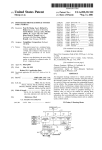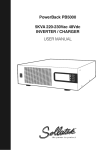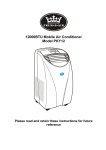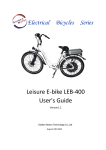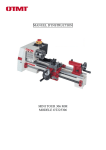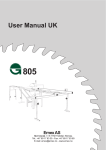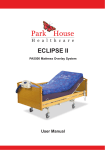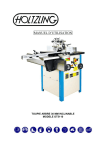Download Axminster MCB100A User manual
Transcript
4" MCB100A Metal Cutting Bandsaw 700247 User Manual W Axminster Reference No:MCB100A w w w. a x m i n s t e r. c o . u k AXMINSTER W H I T E Table of Contents 1 General Safety Rules……………………………………………………………1 Electrical Schematic………………………………………………………………2 2 The Quick Vise and Work Set Up……………………………………………...3 3 Special Safety Rules for Metal Saw…………………………………………...4 Before Using the Saw……………………………………………………………..4 Before Each Use…………………………………………………………………..4 Whenever Saw is Running……………………………………………………….5 4 Power Supply……………………………………………………………………..6 Motor Specifications………………………………………………………………6 Earth………………………………………………………………………………...6 Motor Safety Protection…………………………………………………………...6 Wire Sizes………………………………………………………………………….7 5 Unpacking and Checking Contents……………………………………………7 Tools Needed for Assembly……………………………………………………….7 6 Description and Characteristics………………………………………………8 7 Operating…………………………………………………………………………..9 Rate of Feed ………………………………………………………………………9 Angle Cutting………………………………………………………………………9 Blade Direction of Travel………………………………………………………….9 Changing Blade …………………………………………………………………..10 Vertical Cutting…………………………………………………………………….11 Magnetic Switch…………………………………………………………………..11 8 Adjustment……………………………………………………………………….12 Adjusting Blade Guide……………………………………………………………12 Adjusting Poor Cutting……………………………………………………………12 Maintain Gear Transmission…………………………………………………….13 Blade Tension Adjustment……………………………………………………….13 9 Part List ………………………………………………………………………..14~17 1. General Safety Rules WARNING 1. Read and understand instructions of this manual entirely before operating the machine. 2. Always wear approved safety glasses /face shields when using the machine. 3. Make certain the machine is properly grounded. 4. Before machine in operation, remove ties, rings, watches, other jewelry, and roll your sleeves up to above elbows. Remove loose clothing and confine long hair. 5. Keep the floor around this machine clean and free of scrap material, oil and grease. 6. Keep machine guards in place at all times when the machine is in use. If it removed for maintenance purpose, pay extra attention and replace these guards at once. 7. Do not over reach. Keep a balanced stance all the time so that your don’t fall lean against blade or some other moving parts. 8. Whenever make any adjustments or maintenance with the machine must unplugged the power source 9. Use the right tool. Don’t force a tool or attachment to do a job that it was not designed for. 10. Replace warning labels if they have become obscured or removed. 11. Make certain the motor switch is in “off” position while connecting the machine into the power supply. 12. Pay your work undivided attention. Looking around, and carrying on a conversation, or “ horse-play ” are careless acts which might result in serious injury. 13. Keep visitors a safe distance from the work area. 14. Use recommended accessories, and parts. Improved accessories may be hazardous. 15. Form the good habit of checking to see keys and wrenches are removed before turning on this machine, 16. Always keep hands & fingers away from the black when this machine is running. 17. Never hold a material with this saw in the horizontal position. Please be sure always use the vise to clamp it securely. 18. Read and understand warnings that posted on the machine. 19. Always provide necessary support for long and heavy material 20. Use a sharp blade and always keep machine clean for a best and safest performance. 21. Failure to comply with any of these warnings may cause serious injury. BEFORE CUTTING Loosen the lock plate (A) in Fig 1 to release this saw. After service, must replace the lock plate, and fasten it properly for your safety and carry. Failure to comply with the warning could result in personal injury and machine damage. 2.The Quick Vise And Work Set Up Fig. 1 USAGE OF THE QUICK VISE Novel and improved “quick action” vise has been mounted on the machine. Three pieces of devices & one handle simply solve all the troubles you have met in the past. Follow the easy steps as below. You’ll thank for the design we made for your convenience. 1. Lift up the handle (A) in Fig. 2 then you can move the vise forward and backward with ease by holding the wheel (B) at the left end of base. 2. Push the vise jaw (C) toward the work, make it as close as possible against the other vise jaw which is fixed. CAUTION ! NEVER OPERATE SAW BLADE GUARDS IN PLACE WITHOUT WORK SET UP 1. Raise saw head to vertical position. 2. Open vise to accept the piece to be cut by pulling the wheel at the end of the base. 3. Place work piece on saw bed if the piece is long, support the end. 3. Replace handle by pressing it down. 4. Turn the wheel (B) clock-wise to make sure the work is well located. During operation, you shall find it more convenient & more powerful to fulfill the clamp job than any of traditional ones could offer. Fig. 2 3.Special Safety Rules For Metal Saw WARNING: For your own safety, do not operate your metal saw until it is completely assembled and installed according to the instructions…and until you have read and understood the following. Before using the saw: 1. Assembly and alignment. 2. Learn the function and proper use of: A. The on-off switch. B. The upper and lower blade guards. C. The arbors lock and handle latch. D. The bevel clamp, fence clamps, and metal lock handle. 3. Read and understand all safety instructions and operating procedures throughout the manual. 4. Read the warning label on the metal saw. Before each use: 1. Inspect your saw. If any part of this metal saw is missing, or bent, or has failed in any way, or any electrical parts do not work properly, turn the saw off and unplug the saw. Replace damaged, missing, or failed parts before using the saw again. 2. Plan your work to protect your eyes, hands, face and ears. A. Wear safety goggles (not glasses) that comply with DIN58214 (show on package). Using any power tool can result in permanent eye damage. Goggles are available at stores. Use of glasses or use of goggles not in compliance with DIN58214 could result in severe injury form breakage of the eye protection. B. For dusty operations, wear a face shield along with safety goggles. C. To avoid injury from jams, slips or thrown piece: It is important to choose the right blade for the material and the type of cutting you plan to do. This saw is equipped with a bi-metallic blade which can be used to cut stainless steel, steel, iron, brass, aluminum, wood, plastic and so on. • Make sure the direction of rotation arrow on the blade matches the direction arrow on the saw. The blade teeth should always point downward at the front of the saw. • Make sure the blade is sharp, undamaged and property aligned, with the saw unplugged, push the power-head all the way down. Head spin the blade and check for clearance. Tilt the power-head to 45 degree level and repeat the check. If the blade hits anything, make the adjustments shown in the Maintaining Maximum Cutting Capacity section. • Make sure the blade and arbor collars are clean. • Make sure all clamps and locks are tight and there is no excessive play in any parts. • Never cut EREEHAND: a. Brace your workpiece solidly against the fence and table top so it will not rock or twist during the cut. Make sure no debris is caught beneath the workpiece. b. Make sure no gaps between the workpiece , fence and table will let the workpiece shift after it is cut in two. c. Use jigs, fixture or a different tool for unstable workpieces. • Never cut more than one workpiece at a time. • Make sure the cut-off piece can move sideways after it is cut off. Otherwise, it could get wedged against the blade and thrown violently. • Make sure bystanders are clear of the tool and workpiece. Keep them clear of the area behind the saw where debris will be thrown. • Never turn your metal saw “ON” before clearing everything except the workpiece and related support devices off the able. D. To avoid risk of hearing damage, war ear plugs or muffs during extended period of operation. E. To avoid being suddenly pulled into the blade. 1. Do not wear gloved. 2. Remove all jewelry and loose clothing. 3. Tie back long hair. 4. Roll long sleeves above the elbow. F. To avoid injury from accidental starting, always unplug saw before disconnecting the guard, installing or removing any blade, accessory or attachment, or making any adjustment. G. To avoid an electrical shock, make sure your fingers do not touch the metal prongs on the plug when inserting or removing the plug to or from a live outlet. H. Never put lubricants on the blade while it is spinning. I. To avoid burns or other fire damage, never use the saw near flammable liquids, vapors or gases. J. To avoid injury from unsafe accessories use only accessories shown on the recommended accessories list in this manual. Whenever saw is running WARNING: Do not allow familiarity (gained from frequent use of your metal saw) to cause a careless mistake. Always remember that a careless fraction of a second is enough to cause a severe injury. 1. Before actually cutting with the saw, let it run for a while. If your saw makes an unfamiliar noise or if it vibrates excessively, stop immediately. Turn the saw off. Unplug the saw. Do not restart until finding and correcting the problem. 2. Never confine the piece being cut out. Never hold it, clamp it, touch it, or use length stops against it. It must be free to move sideways. If confined, it could get wedged against the blade and thrown violently. 3. Avoid awkward hand positions where a sudden slip could cause a hand to move into the blade. 4. Let the blade reach full speed before cutting. 5. Feed the saw into the workpiece only fast enough to let the blade cut without bogging down or binding. 6. Before freeing jammed material, release switch and unplug the saw. Wait for all moving parts to stop. 7. After finishing a cut, keep holding the power head down, release the switch, and wait for all moving parts to stop before moving your hands. WARNING: Read the following warning labels found on the front of the saw. DANGER • • • • Keep hands out of sawblade path. Never cut anything freehand. Never reach behind or beneath blade. To avoid electric shock, do not expose to rain. • Tighten arbor screw and all clamps before turning power on. 4.Power Supply Motor specifications The AC motor used in this saw is a conduction, nonreversible type having the following specifications: Maximum capacity (KW) 0.375 Voltage (V) 230 Amperes (A) 2.23 Frequency (Hz) 50 Motor speed (RPM) 1430 Earth This metal saw is single insulated tool, so the earth system is provided to protect you from being shocked. The appropriate earthing system is set up as soon as this machine is plugged into the proper power supply system. Therefore, the standard power supply system, shall be provided for this machine in order to protect you from the risk of shock. DANGERA: To avoid electric shock 1. Do not change the power cord and plug into another specification provided by the manufacturer. 2. Do not use in rain or where floor is wet. This tool is intended for indoor residential use only. Motor safety protection CAUTION: To avoid motor damage, this motor should be blown out or vacuumed frequently to keep sawdust from interfering with normal motor ventilation. 1. If the motor does not start, release the trigger switch immediately. UNPLUG THE TOOL. Check the saw blade to make sure it turns freely. If the blade is free, try to start the motor again, if the motor still does not start, refer to the “Motor Trouble Shooting Chart”. 2. If the motor suddenly stalls while cutting wood, release the trigger switch, unplug the tool, and free the blade from the wood. Then you may restart the motor and finish the cut. 3. Fuses may “blow” or circuit breakers may trip frequently if: a. Motor is overloaded-overloading can occur if you feed too rapidly or made too many start/stops in a short time. b. Voltage not more than 10% above or below the nameplate voltage can handle normal loads, for heavy loads, however, the voltage (caused by a small size wire in the supply circuit or an overly long supply circuit wire)may drop too low for the motor to operate. Always check the connections, the load and the supply circuit whenever motor does not work well. Check wire sizes and length with the Wire Size Chart below. 4. Most motor troubles may be trace to loose or incorrect connections, overload, low voltage (such as small size wire in the supply circuit) or to overly long supply circuit wire. Always check the connections, the load and the supply circuit whenever motor doesn’t work well. Check wire sizes and length with the Wire Size Chart below Wire sizes The use of any extension cable will cause some loss of power. To keep this to a minimum and to prevent overheating and motor burn-out, use the table below to determine the minimum wire size (lead cross-section) of an extension cable. For circuits that are more than 40m away from the electrical service box, the wire size must be increased proportionately in order to deliver ample voltage to the saw motor. Length of the conductor Up to 15m 15-40m Wire Sizes Required For 230V 1.5mm2 2.5mm2 ITEM Contents the Metal Saw is shipped complete in one carton. Separate all parts from packing. Material and check each item with illustration and “Table of Loose Part”. Make certain all items are accounted for, before discarding any packing material. WARNINGA: If any parts are Q’TY A Basic Saw Assembly 1 B Stop Rod Assembly 1 C Saw Head Knob 1 D 5.Unpacking And Checking TABLE OF LOOSE PARTS E 90º Support Bar Assembly Instruction Manual 1 1 Tool needed for assembly Note: The shown tools are not standard deliver with this saw. Medium Screwdriver Adjustable Wrench missing, do not try to assembly the metal saw, plug in the power cable or turn the switch on until the missing parts are obtained and installed correctly. Combination Square 13mm Hex. Soc. ”L” Wrench 6. Description And Characteristics unusual happens on your gear transmission system, do not try to fix or restore it personally. Send it back to your dealer for check-up or repairmen. Failure to comply can result in machine damage. 1. This 4” portable band saw is made as light as 31kgs by weight & equipped with an easy carrying handle for your fitness to transport to any worksites. 6. The machine combines miter, vertical and horizontal cutting and is designed for full efficiency & operator convenience in each position. 2. The body of this machine is formed with Aluminum Die Casting (Alum Casting is optional) such that body construction of it becomes sturdier and appearance smoother and more acceptable. 7. An auto shutoff assures the complete cut work, thus permitting unattended operation. 3. During operation, the noise level of this machine is about 80 dB which is mush less than any of the other band saws, and of course, it can present a comfortable working environment. 4. This machine is made ready for the blade tension adjustment by holding the handle to give a little turn for the tension increasing, or decreasing as you wish during the period of blade replacement or machine in operation. Also attached with the handle, there are a couple of compression springs set up for reducing vibration that is from a defective workpiece popping while machine is running. It permits the blade to be used much longer. 5. The drive of this machine is through gear transmission that gives steadier, stronger, and smoother cuts superior to any of pulley drive band saws, and make less trouble after service. Note: if anything WARNING SHUT OFF THE POWER SOURCE AT ALL THE TIME, BEFORE THE MACHINE IS IN MAINTENANCE, OPERATION, ADJUSTMENT, OR REPAIRMENT. WARNING Disconnect machine from the power source! No matter when, where, or how. Pay extra attention to the saw during it in transportation, operation, maintenance, or adjustment. Failure to comply may cause serious injury! 7.Operating INFORMATION BEFORE OPERAION 3. If the pointer is matched by the right degree on the scale. Tighten the bolt, and a perfect angle cut will be given. Be sure the table isn’t in contact with the work when the motor is started. Run the motor, allow the saw to come to full speed. Begin the cut by letting the head down slowly onto the work. DO NOT DROP OR FORCE. Let the weight of the saw provide the cutting force. The saw shuts off at the end of the cut automatically. RATE OF FEED The rate of feed is preset (On Mark H) at the factory for solid metal material cutting. Fig. 3 To decrease feed, proceed as follows: 1. Release the lock-pin by pulling up the Knob (A) in Fig. 3 a little bit. 2. Turn the wheel (B) toward the Knob and stop on the Mark M, let the lock pin slide in the slot. The rate of feed is for thick metal pipes cutting. 3. Turn the wheel and stop on the Mark L and lock it on the position, the rate of feed is for thin metal pipes cutting. ANGLE CUTTING The machine uses a swivel miter base for angle cutting from 0~45 degree. On the swing arm, there is a pointer (A) in Fig. 4 attached. This machine is preset zero degree before leaving the factory. Angle cutting is adjusted as follows. 1. Loosen bolt (B) to release the arm. 2. Move this swivel arm forward along the scale that is for searching a right angle for the work to be cut. Fig. 4 B L A D E D I R E C T I O N O F T R AV E L Be sure this blade is assembled to the wheels such that the vertical edge can engage the work piece first. ! WARNING Disconnect machine from the power source! guide bearings. Make sure the teeth of blade face down toward the bed No mater when, where, or how. Pay extra attention to the saw during it in transportation, operation, maintenance, or adjustment. 6. Fasten the tension handle clockwise move the blade by pulling it down with one hand and it will be tracked onto wheels properly. 7. Replace blade cover (G) and guards. And start the machine to see that the blade runs properly. Failure to comply may cause serious injury! CHANGING BLADE 1. Raise this saw head up-to 90 degree by lifting up knob (A) in Fig. 5 a little bit to release the lock-pin, and slide it into the slot that is made for setting the saw arm in vertical position. 2. Remove this blade guards (B), and blade cover by loosening two bolts (C) on the saw frame. 3. Push tension handle (D). Counter wise to let the blade slip off. 4. Remove blade from both wheels (E), and blade guide bearing (F). 5. Place a new blade on the flanges of wheels but not too tight, twist blade slightly and let it slip into between each of Fig. 5 VERTICAL CUTTING 1. Fasten the supporting bar (A) in Fig. 6 into the slot at the saw head. 2. Raise saw head to vertical position by lifting up the knob (B) a little to release the lock-pin and slide it into the slot which is set for 90 degree. 3. Remove the small plate (C). 4. Before cutting a bigger work, take away the carrying handle (E). After service, replace the handle. Fig. 6 Caution: Be sure that the machine is disconnected from the power source before attempting to service or take any component away! MAGNETIC SWITCH The band saw is equipped with TRIPUS magnetic switch which is designed for operating safety. After power failure, the machine has to be restarted by opening the cover and pushing the inner “ ON “ button. There is a red button attached on the switch cover, depress it to stop all machine functions if emergency. This magnetic switch also connects with the limit switch at the back of bed, when the work piece is completely cut, both switches will shut off automatically. MAGETIC SWITCH 8.Adjustment ADJUSTING BLADE GUIDE An unbounded handle is mounted on the unit for freely changing direction by lifting it up and turning a little bit. It’s designed for your convenience to adjust blade guide easily and quickly at any time, and under any situation. Adjustment of this blade guide is in accordance with the sizes of work pieces. The only one located at the left of the saw head can be adjusted and the other is fixed. Fig.7 1. If the work is big, loosen the handle (A) in Fig.7. move the guide toward the work about one inch then tighten the handle. 1. Bad cuts due to blade worn, replace a new blade. 2. When cutting a small work, move the guide toward the work as close as it can be. Both cuttings will present you satisfactory jobs. 2. The saw uses fixed ball bearings. For keeping proper cutting, the best way is to replace them every three or six months depending on the frequency of service. WARNING Do not make any adjustments, or load, unload work from vise when machine is running! 3. Poor cuts can be made because the fixed nut (A) is getting loose. Then tighten it properly. ADJUSTING POOR CUTTING The machine has been adjusted and power-tested with several test cuts before leaving the factory to insure proper cutting. If there is any poor cuts occurred, correct it as follows. MAINTAIN GEAR TRANSMISSION The gears of the transmission system equipped with this machine are made of a special kind of steel. WARNING SHUT OFF THE POWER SOURCE BEFORE MACHINE IS RUNNING ADJUSTMENT, MAINTENANCE, OR REPAIRMENT. The quality insures that the gears will be more sturdy and durable. In order to keep the performance as perfect as they are designed for. We suggest that a lubricant shall be required for them every three months. To fulfill the job follow the steps as below. 1. Loosen the screw (A) in Fig. 8 with a 8mm Hex. wrench. 2. Remove the wheel (B), then lubricate the gears with Anti-high heat grease. 3. Replace this wheel with care, then tighten the screw (A) properly. Fig.8 BLADE TENSION ADJUSTMENT The tension device of this machine is designed for the ready service basis. All you have to do is hold the handle (B) in Fig. 6 to control blade tension by giving turn to increase or decrease tension as you wish during machine in operation. The major function of it is to present a perfect cut, because it can make the blade work on constant tension. Furthermore, attached with the tension system, there are a couple of compression springs which are made for decreasing the blade backlash. Consequently, it is for sure to extend life of the blade. BEFORE STARTING MAKE SURE LOOSEN THE LOCK PLATE BETWEEN THE SAW ARM AND BED TO RELEASE THE SAW. AFTER SERVICE, REMEMBER IT MUST BE REPLACED BACK FOR SAFETY AND EASY CARRYING. Part PART NO. 1 2 3 4 5 6 7 8 9 10 11 12 13 14 15 16 17 18 19 20 21 22 23 24 25 26 27 28 29 30 31 32 33 34 35 36 37 38 39 40 41 42 43 44 45 46 47 DESCRIPTION Base Transport Lock Thick Washer (large) 6mm Hex. Bolt M6x25 Set Cap Nut Hex. Bolt M6x12 0º~45º Lock Washer Stop Rod Stop Block Thumb Screw Hex. Soc. Screw M6x12 Spring Nut Wheel Handle Hand Wheel Hex. Soc. Screw M6x6 Hex. Bolt M8x16 Washer 8mm Nut Seat Hex. Soc. Screw M5x12 Nut M5 Eccentric Shaft Eccentric Handle Key 5x5x15 Lead Screw Vise Jaw (Left) Hex. Soc. Screw M5x16 Nut M5 Hex. Bolt M6x12 Washer 6mm Set Plate Square Guard Tube Screw M6x30 Vise Jaw (Right) Washer 10mm Hex. Bolt M10x20 Set Cover Bushing Spring Pin Hex. Bolt M6x12 Washer (large) 6mm Nut M8 Spring Adjusting Plate Hex. Soc. Screw M8x30 Spring Set Seat Spring Q’TY 1 1 1 1 1 2 1 1 1 1 1 1 1 1 1 1 2 2 1 1 1 1 1 1 1 1 1 1 2 2 1 2 2 1 2 2 1 1 1 1 1 1 1 1 1 1 1 List PART NO. 48 48-1 49 50 51 52 53 54 55 56 57 58 59 60 60-1 60-2 61 62 63 64 65 66 67 67-1 68 69 70 71 73 74 74-1 75 76 77 78 79 80 81 82 83 84 84-1 85 86 87 88 89 DESCRIPTION Q’TY Cut Off Power Cam Screw M8x10 Key 4x4x20 Joint Shaft Key 4x4x12 Screw M6x10 Support Plate Swivel Support Elbow Hex. Soc. Screw M8x20 Spring Washer 8mm Hex. Soc. Screw M8x40 Flat Washer Nut 8mm Hex. Bolt M8x45 Hex. Bolt M8x35 Nut 8mm Flat Washer Swivel Miter Base Hex. Bolt Cross Screw M5x16 Limit Seat Bushing Washer δ1.5 Flat Washer δ3 Hex. Soc. Screw M8x20 Spring Pin 3x20 Set Pin Spring Set Knob Cross Screw M5x10 Washer 5mm Pointer Plate Cross Screw M4x10 Cross Screw M5x30 Limits Switch Switch Plate Cross Screw M5x10 Hex. Soc. Screw M5x25 Ball Bearing 625z Spring Washer 5mm Washer 5mm Cross Screw M4x6 Blade Guard (Left) Adjustable Bracket (Left) Saw Head Knob Nut M8 1 1 1 1 1 2 1 1 1 1 1 1 1 1 1 1 1 1 1 4 1 2 1 1 1 1 1 1 1 1 1 1 1 4 2 1 1 2 2 4 2 2 2 1 1 1 1 Part PART NO. 90 91 92 93 94 95 96 97 98 99 100 100-1 101 102 103 104 105 106 107 108 112 113 114 115 116 117 118 119 120 121 122 123 124 125 125-1 125-2 125-3 126 126-1 126-2 126-3 127 128 129 130 131 131-1 DESCRIPTION Blade Tension Handle Shaft Blade Wheel Seat Tooth Blade Wheel Swat Nut M6 Blade Tension Block Compression Spring Lock Bolt U-Shape Plate Compression Spring Hex. Bolt M6x10 Guide Plate Blade wheel Shaft (Left) Screw M6x12 Blade wheel (Left) Ball Bearing 6003z C-Ring 35 Washer (Large) 8mm Spring Washer 8mm Hex. Bolt M8x45 Cross Screw M5x10 Blade Cover Hex. Bolt M8x50 Spring Washer 8mm Washer (Large) 8mm Blade C-Ring 35 Ball Bearing 6003z Rubbing Ring Blade Wheel (Right) Felt Pad Down Speed Cog Hex. Soc. Screw M6x12 Blade Wheel Shaft (Right) Saw Arm Motor Shaft Washer Centrifugal Switch Cross Screw M4x6 Motor Case Motor Shell Washer 6mm Cross Screw M6x6 90º Support Bar Nut M10 Hex. Soc. Screw M5x16 Spring Washer 5mm Magnetic Switch Capacitor Q’TY 1 1 1 2 1 2 1 2 4 2 1 2 1 2 1 1 1 1 2 1 1 1 1 1 1 2 1 1 1 1 3 1 1 1 1 1 2 1 1 1 1 1 1 4 4 1 1 List PART NO. 132 132-1 133 134 135 136 136-1 137 142 143 144 145 146 147 148 149 150 150-1 151 152 153 154 155 156 157 158 158-1 159 160 161 162 162-1 163 165 166 167 168 169 DESCRIPTION Switch Case Cross Screw ST 4x10 Cross Screw M5x10 Nut M12 Washer (Large) 12mm Ball Bearing 625z Round Key Carry Handle Cross Screw M4x10 Blade Cover (Right) Hex. Bolt M8x20 Spring Washer 8mm Ball Bearing Seat Ball Bearing 625z Round Key Hex. Bolt M6x25 Spring Washer 5mm Flat Washer 5mm Ball Bearing 625z Hex. Soc. Screw M5x25 Ball Bearing Protecting Plate Screw M6x10 Hex. Soc. Screw M5x12 Blade Tension Adjustable Handle Bushing Hook Washer 8mm Hex. Bolt M8x12 Knob M8x25 Washer 8mm Power Cord Wire Scale Nut M10 Hex. Bolt M10x30 Iron Box Screw M5x10 Plate Q’TY 1 2 4 1 1 1 1 1 2 1 2 2 1 2 2 2 2 2 4 2 1 2 1 1 1 1 1 1 1 1 1 1 1 1 1 1 2 1 MCB100A Metal Cutting Bandsaw 700247 Axminster Reference No:MCB100A W Axminster Devon EX13 5PH UK AXMINSTER W H I T E FREEPHONE 0800 371822 www.axminster.co.uk




















